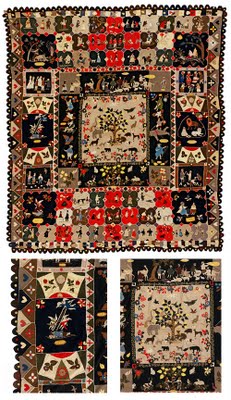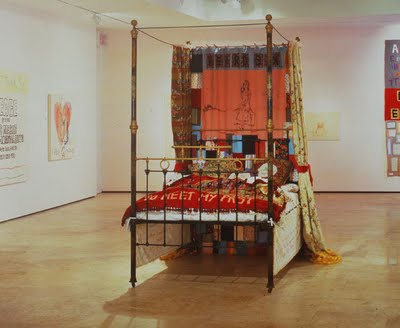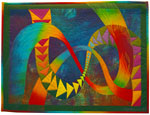V and A - Quilts 1700-2010 - One Not to Miss!
If there is one thing that needs to go in the diary, friends contacted, plans made, tickets purchased and train seats allocated in 2010 its the forthcoming exhibition at the Victoria and Albert Museum in South Kensington, London entitled Quilts 1700-2010.


The marketing department seems to be doing a great job as we've seen mention of it in the Daily and Sunday Telegraph, the Times and plenty of other places. We're very excited as a few of us will be going to the preview on the 17th March.
The exhibition is a unique opportunity to view the V&A's unseen quilt collection as well as key national loans.
The Curator's blog makes for great reading as the opening of the exhibition is about two weeks away. You know how it is for most of us, its Christmas Eve and the quilt binding is still being sewn on as Father Christmas is appearing boots first down the chimney...talk about last minute. So imagine how much work will be going on getting the exhibition ready in time!
The exhibition includes some quilts featured on beds such as the 2002 Quilt entitled "To Meet My Past" by Tracey Emin. 

We recently discovered some interesting family history (we had no idea until a few weeks ago) of relatives who were silk merchants and other who were involved in the dyeing industry in London - including such exhuberant and interesting characters as Charles Candy otherwise known as Beau Candy or Sugar Candy (this was in the late 1700s, early 1800s so the time of Beau Brummel, lots of silk cravats and dashing Regency style gents!). The thought of visiting an exhibition based on quilts made from fabrics manufactured during this period is fascinating.
In doing the research it was interesting to discover that William Shipley, who formed the RSA (the Royal Society for the Arts, Commerce and Manufactures) which is now 250 years old and which is based at John Adams House in London, recognised the importance of the manufacture of silk and cotton in England. Dyeing prior to the mid 1750s was mostly done in France. However, the expulsion of the Huguenots from France (the biggest migration in history, many of whom, including my relatives, moved to England in the 1600s and 1700s) led to those skills being brought to London and the development of the dyeing industry along the rivers such as the Wandle and Lea which feed into the Thames in London. Without that impetus England may never have had the level of fabric production that we did during that period. Whilst fabric production in the UK is minimal now we're glad that some of the design and certainly the development of fabric designs still happens here.
We hope you are able to visit the Exhibition while it is on - it finishes on the 4th July 2010.
Labels: Quilt Show, RSA, Tracey Emin, Victoria and Abert Museum




3 Comments:
For Germaine Greer's take on the V&A - an alternative perspective - http://www.guardian.co.uk/artanddesign/2010/mar/14/germaine-greer-textiles-quilts
I've posted a round-up of the press reviews on www.TextileHunter.blogspot.com.
Thanks Sally - nice to see you yesterday. I'll repost your link on my more recent post too.
Liz
Post a Comment
<< Home